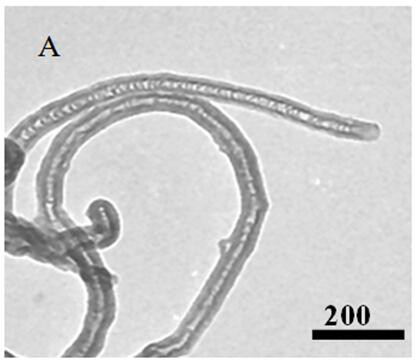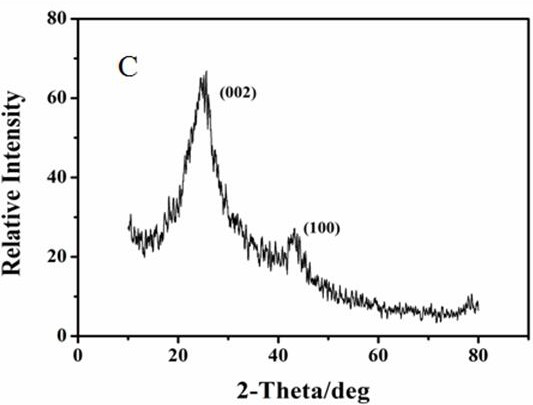Preparation and application of biosensor based on N-graphene nanobelt-gold platinum nanocluster
A graphene nanoribbon and biosensor technology, applied in the field of biosensors, can solve the problems of high requirements for testing personnel, cumbersome operation process, complex instruments and equipment, etc., and achieve the effects of shortened detection time, simple preparation and wide application range
- Summary
- Abstract
- Description
- Claims
- Application Information
AI Technical Summary
Problems solved by technology
Method used
Image
Examples
Embodiment 1
[0041] Preparation of N-graphene nanobelt-gold platinum nanocluster composite
[0042] (1) Mix 0.1g N-multiwalled carbon nanotubes with 30mL H 2 SO 4 / H 3 PO 4 (9:1) The mixed solution was placed in a microwave reaction bottle, and the temperature of the microwave reactor was controlled at 110 °C for 2 min. After cooling for 10min, add 2g KMnO to the reaction solution 4 , the microwave temperature was controlled at 65°C for 4 min. Cool to room temperature, wash thoroughly with ultrapure water until neutral. The obtained black solid, that is, N-graphene nanobelts, was dried under vacuum at 35°C-40°C.
[0043] (2) Mix 1mL 10mg / mL PVA solution with 200mL 0.25mM AuCl - 4The solutions were mixed. Stir vigorously for 1 h, then add 5 mL of 0.1 M fresh trisodium citrate solution dropwise, and stir the solution for 2 h to generate Au colloids (particle size 3.0 nm). Add 10 mL of 1 mM K to the pre-prepared gold colloidal solution 2 PtCl 6 and a solution of 5 g / L PVP. After b...
Embodiment 2
[0050] The difference between this embodiment and Example 1 is that the preparation of the biosensor of N-graphene nanoribbons-gold platinum nanoclusters:
[0051] (1) Use A1 2 o 3 A glassy carbon electrode with a diameter of 4 mm was powder-polished and rinsed with ultrapure water.
[0052] (2) Take 10 µL of the stock solution of the N-graphene nanoribbon-AuPt nanocluster composite and drop it on the glassy carbon electrode, and then dry it to prepare the bio sensor.
Embodiment 3
[0054] Preparation of N-graphene nanobelt-gold platinum nanocluster composite
[0055] (1) Mix 0.5g N-multiwalled carbon nanotubes with 200mL H 2 SO 4 / H 3 PO 4 (9:1) The mixed solution was placed in a microwave reaction bottle, and the temperature of the microwave reactor was controlled at 140 °C for 3 min. After cooling for 15min, add 10g KMnO to the reaction solution 4 , the microwave temperature was controlled at 85°C for 10 min. Cool to room temperature, wash thoroughly with ultrapure water until neutral. The obtained black solid, that is, N-graphene nanobelts, was dried in vacuum at 40° C. for 1 h.
[0056] (2) Mix 0.5mL 10mg / mL PVA solution with 170mL 0.25mM AuCl - 4 The solutions were mixed. Stir vigorously for 1h, then add 12mL of 0.1M fresh trisodium citrate solution dropwise, and stir the solution for 2h to generate Au colloids (average particle size 6.0nm). Add 50 mL of 1 mM K to the pre-prepared gold colloidal solution 2 PtCl 6 and a solution of 5 g / L P...
PUM
| Property | Measurement | Unit |
|---|---|---|
| particle diameter | aaaaa | aaaaa |
Abstract
Description
Claims
Application Information
 Login to View More
Login to View More - R&D
- Intellectual Property
- Life Sciences
- Materials
- Tech Scout
- Unparalleled Data Quality
- Higher Quality Content
- 60% Fewer Hallucinations
Browse by: Latest US Patents, China's latest patents, Technical Efficacy Thesaurus, Application Domain, Technology Topic, Popular Technical Reports.
© 2025 PatSnap. All rights reserved.Legal|Privacy policy|Modern Slavery Act Transparency Statement|Sitemap|About US| Contact US: help@patsnap.com



